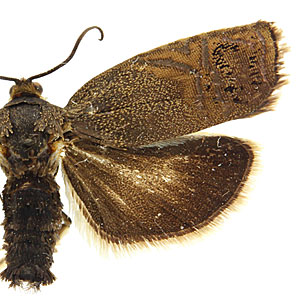Adult Recognition

FWL: 7.0-10.0 mm
Forewings are brown to golden brown. Metallic bands, or striae, extend diagonally from the costa to the ocellus and continue vertically to the dorsum. Hindwings are brown to near black.
Adults may appear similar to other species of Cydia. A genitalic dissection can be used to confirm identity.
Larval Morphology

Late instar larvae are approximately 20 mm in length and are pinkish with medium to large, pale-brown pinacula. The head is brown and the prothoracic shield is light brown. Diagnostic characters include: L pinaculum of T1 rather large, sometimes notched; L setae on A9 sometimes all on the same pinacula; SV-group setal counts 3:3:2(3):1(2):1; number of crochets 34-37.
Biology

Cydia araucariae completes several generations per year. Adults are active during the day.
Females usually lay eggs on the female cones, but eggs may also be found on the needles, twigs, terminal buds, and male cones. Larvae tunnel into the seeds, where they complete development. Larvae may also damage terminal buds. Pupation occurs in a silken cocoon.
Host plants
Larvae of C. araucariae feed in the seeds of Brazilian pine.
| Family | Genus/species | Common name |
| Araucariaceae | Araucaria angustifolia (Bertol.) Kuntze | Brazilian pine |
Distribution

Cydia araucariae is found in association with its larval host in Brazil, Argentina, and possibly Chile.
References

Mecke, R. 2002. Insects of the Brazilian Pine. Attempto Service GmbH, Tubingen, Germany. 79 pp.
Pastrana, J. A. 1950. Una nueva peste en Araucaria de Misiones Republic Argentina "Lepidoptera - Grapholitidae." De la Revista de Invest Agricultura. 4: 243-244.

